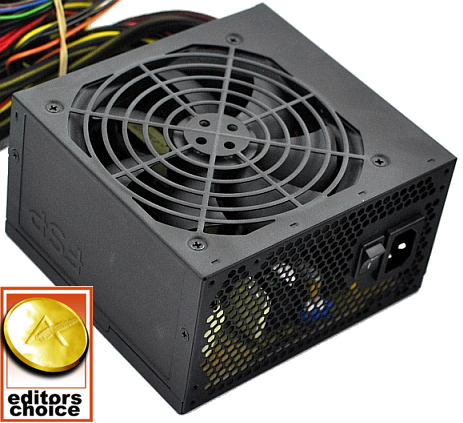350-450W Roundup: 11 Cheap PSUs
by Martin Kaffei on July 3, 2012 1:30 PM ESTConclusion
Some PSUs have no right to exist. The Sinan Power VP-430 430W at €22.40 (about $28) belongs in this classification if you want a reliable PSU. The Sinan Power is a ~215 watts power supply without active power factor correction—not to mention the fact that the efficiency is always below 75%. Sinan Power offers nothing more than three SATA and a few HDD connectors on very short cables. Once again it can be stated that you get what you pay for!
The be quiet! System Power 350W at €29.75 (about $37) is one of the 350W units we can recommend for Office use. The downside of the PSU is that there is no connector for graphics cards, but this shouldn't hurt too much. Three SATA and HDD connectors are provided and there is a floppy connector at 75cm. be quiet! uses Taiwanese capacitors like most manufacturers in this roundup. be quiet! will be finally entering the US market later this year which is a good news for enthusiasts as they deliver the quietest PSUs in Germany.
Thermaltake offers a few power supplies which come up to expectations but the Thermaltake Smart AP-430P 430W at $61.99 didn't do well as the efficiency was low. 83.64% is the highest value we measured during the test. During 20% load Thermaltake didn't even surpass the minimum requirement for 80 Plus. You get the usual set of accessories and cables, but there are no unique features or remarkable results, which should be mentioned.
The Rosewill Green Series RG430-S12 430W at $44.99 provides many connectors except the PCI-E plugs. The model reached up to 84% efficiency and more than 40mV ripple and noise on the smaller rails. This should be avoided next time. However, the PSU stays stable all the time and comes with several extras such as cable ties. In summary, the RG430-S12 is a decent mainstream PSU.
The OEM models by FSP (FSP400-60APN 230V version and FSP400-60GHN(85)) performed well in our test. All the modern FSP PSUs we've reviewed have no problems with ripple and noise, and that trend continues here. However, both models provide just a 4-pin CPU connector and 6 to 9 peripheral plugs. Additionally, you get only one 6-pin connector for graphics cards. Like most PSUs in this roundup both models have all important safety functions including OCP and a common forward converter. All in all we have to criticize the cable configuration, which plays an important part when building a PC.
| Comparison: Max. Efficiency | |
| PSU | Efficiency (230VAC) |
| FSP Raider | 90.54% |
| FSP400-60GHN(85) | 86.76% |
| Enermax NAXN | 86.39% |
| Rasurbo RAP | 86.27% |
| be quiet! System Power | 85.86% |
| Corsair CX430 V2 | 84.90% |
| FSP400-60APN | 84.64% |
| Rosewill Green Series | 83.73% |
| Thermaltake Smart | 83.64% |
| Sinan Power VP-430 | 74.13% |
The Corsair CX430 V2 430W at $39.99 is an affordable power supply with low ripple on all rails. The number of connectors and their distribution is satisfying as well. During the load test the regulation of the output voltage is sufficient, and the efficiency is decent for an 80Plus model. The contents of the package are also very welcome. The power supply uses a well known layout from CWT and it's a cheaper design. The relatively low-end capacitors are acceptable for a PSU in this range. Under load the power supply is clearly audible, reaching up to 27 dBA.

The Rasurbo RAP350 350W at €30.84 (about $39) and RAP450 450W at €43.59 (about $55) use Taiwanese capacitors from Teapo, there's a lot of space for cooling and airflow, and they've chosen better MOSFETs than Thermaltake. The RPMs are tolerable up to 50% load causing a low fan noise. In terms of voltage stability, the 3.3V rail measures 3.19V during our overload scenario. All the other outputs are closer to their optimal values. The package includes all important extras and 86% efficiency is pretty nice. In addition there are two PCI-E connectors at the 450W model. We are pleased to present Rasurbo with our Bronze Editors' Choice award.

The Enermax NAXN ENP450AWT-B 450W (no price available) is very efficient and stable. In addition Enermax provides one more SATA connector and longer cables than Rosewill which is usually more important than a few additional HDD plugs. There is no heavy increase in acoustic noise during operation, but the fan already starts at a high RPM. Beside this we couldn't find any major flaws. Inside we found the same double forward topology Corsair used. However, Enermax has more efficient components and the cable configuration is more extensive. In addition the NAXN used a better looking cable sleeving, probably the best in this roundup. Enermax also performed well, reaching low ripple and noise results and an ideal voltage regulation. Last but not least we can recommend the PSU because of features like the HeatGuard and many safety functions. Enermax deservedly earns our Silver Editors' Choice Award for providing a (nearly) flawless product.
The FSP Raider 80Plus Bronze 450W at a MSRP of $55 is the most expensive PSU in this roundup for the simple reason that they offer the best product. FSP provides two PEG connectors instead of one (which is enough to run either a lower-end SLI/CF setup or a single high-end graphics card with two PEG jacks), a 5-year warranty and a very high efficiency. In fact the efficiency was ~4 percentage points above the second best result (230VAC) and way above the necessary values for 80Plus Bronze (Silver at 115VAC, Gold at 230VAC). FSP integrated well chosen components and the well known active-clamp design. Moreover FSP implemented all safety functions including OCP. Five SATA connectors and a very long CPU cable perfect the PSU. The fan's RPM and the load rise equally, but the noise is still acceptable compared to the Aurum models. We’re awarding FSP our Gold Editors’ Choice award.











67 Comments
View All Comments
Freddo - Tuesday, July 3, 2012 - link
I bought a FSP Aurum 400W 80 Plus Gold about a year ago, and I'm EXTREMELY pleased with it. It's very cool and energy efficientI have my computer on pretty much 24/7, but last week I turned it off for pretty much the first time since I got the PSU to install more RAM, and the PSU was still very cool, didn't feel like it was on at all.
http://www.fspgroupusa.com/aurum-gold-400-au400/p/...
jasonnovak - Tuesday, July 3, 2012 - link
This power supply has been on sale for under $20 after rebates a few times over the last months - it's on sale right now for another day, at newegg 15% off code and rebate.It's a re-badged Seasonic S12II - high quality unit. I got a few as spares, use a HCG-620 myself.
Guspaz - Tuesday, July 3, 2012 - link
I've got a Shuttle SZ77R5 with a 500W PSU, running an i7-3770k and a GeForce GTX 670... It doesn't get all that much faster than this without your cost/performance ratio going to crap, and the 500W PSU is way more than enough.Why this is the case should be obvious: the processor has a 77W TDP, the graphics chip has a tdp of 170W, which is 247W at full load, and those are the two biggest power draws in the case. Yes, the other parts use power, like the hard disks (I've got SSDs), fans, memory, chipset, etc. but not enough to max out even a 500W PSU.
QChronoD - Tuesday, July 3, 2012 - link
For your system a 500W supply sounds great, but for other people they might have more stuff in their box that needs more power. For example, my main system has an i7-920, GTX 560, and 14hdds. It was giving me random fits occasionally when rebooting on my old 650W supply (can't remember the name but I believe it was one of the recommended ones either on here or tom's or someplace) I ended up replacing it with an 850W and now I don't get restart cycles anymore. Theoretically, the 650W supply had enough power to run everything (and still 100+W of spare capacity), but something wasn't happy and a large supply seems to have fixed everything.Finally - Tuesday, July 3, 2012 - link
Bullshit.What you are describing is the American mentality towards the environment, not much else.
JarredWalton - Tuesday, July 3, 2012 - link
I think he's almost certainly correct in that the PSU was a problem -- HDDs tend to draw power differently than GPUs and CPUs (same voltage, different rails). The real question is what he's doing with 14 HDDs in a single system. Sounds more like something for a file server, and if you're running a file server you should probably also have a higher quality PSU to begin with.As for your contention that he has an "American mentality towards the environment", kindly take your stereotyping elsewhere. Very likely this has nothing at all to do with his nationality and is simply a reflection of his enthusiasm for computers and technology.
KAlmquist - Tuesday, July 3, 2012 - link
Hard drives are commonly designed to draw up to 2 amps on the 12 volt line when spinning up, so if you spin up 14 hard drives at ones the power draw could be 2A * 12V * 14 = 672 watts. Normally, systems with large numbers of hard drives are configured to spin up a few drives at a time to avoid overloading the power supply. The alternative is to do what you did: buy a very large power supply.JimmiG - Tuesday, July 3, 2012 - link
Still running a Corsair 450W VX PSU since 2007 here. Currently with an overclocked Phenom II X4 system and GTX460. Rock solid. I always laugh when people ask whether their new 750W PSU's will be enough for a Sandy Bridge and Radeon 6850 plus one SSD...bwave - Tuesday, July 3, 2012 - link
Why would you consider any of these when you can get a Cooler Master Elite 460W for $29.99 or a Cooler Master 500w for $37.99 ?I've used hundreds of the Cooler Masters with zero failures, very high quality and it's a name brand!
'nar - Wednesday, July 4, 2012 - link
That's what I want to know. I use the same two all the time, but I am almost scared to find out how they actually test.Most users do not notice, and do not care. They only want the cheapest PSU. I may get them to allow me to installed a better one, but only so far. Most of the PSU's reviewed here are marginal in that regard.
We're talking about systems with a core i3 and integrated graphics, and a single hard drive. Maybe it can push 100-120 watts, when the grand kids try to play WOW on their grandparents' computer. Sometimes they want the $25 model even.
Shoot, for office workstations I use these Cooler Masters even. I haven't had a problem yet. Nowadays that means Core-i5, 8GB DDR3, and 60GB SSD. I built a server recently that only used 18watts at idle! It is just hard to find good PSU's at less then 400 watts.